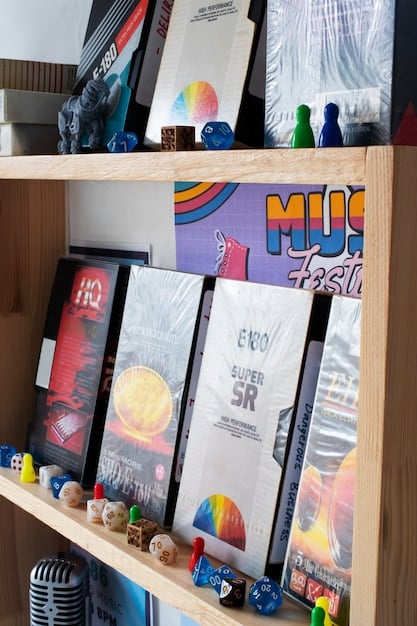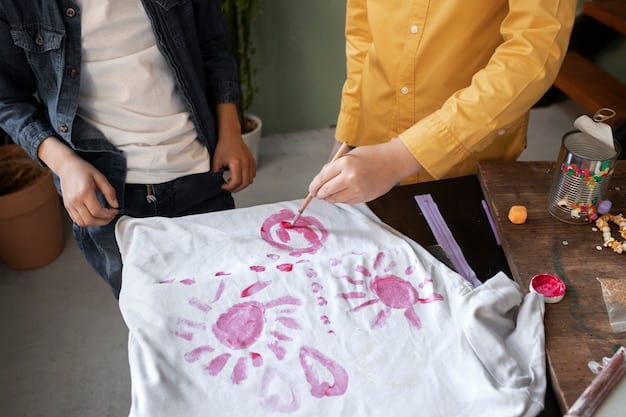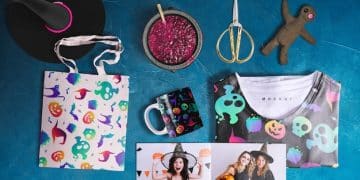Boost Your Art Sales: Merchandising for Emerging Artists

Emerging Artists: Build Your Brand with Effective Merchandising – Increase Revenue by 25% by understanding how effective merchandising strategies can transform your art into a marketable brand, significantly boosting revenue and expanding your reach within the competitive art market.
Are you an emerging artist looking to take your career to the next level? Understanding and implementing effective merchandising strategies can be a game-changer. This guide, titled Emerging Artists: Build Your Brand with Effective Merchandising – Increase Revenue by 25%, will provide you with actionable insights on how to build your brand and significantly increase your revenue through strategic merchandising.
Understand Your Brand as an Emerging Artist
Before diving into merchandising, it’s crucial to have a solid understanding of your brand. Your brand is more than just your artwork; it’s the story you tell, the emotions you evoke, and the values you represent. Defining your brand will help you create a cohesive and appealing merchandising strategy.
Defining Your Artistic Identity
Start by identifying what makes your art unique. What themes do you explore? What techniques do you use? What message are you trying to convey? Answering these questions will help you define your artistic identity.
Target Audience
Who are you trying to reach with your art? Understanding your target audience is essential for creating merchandise that appeals to them. Consider their age, interests, and purchasing habits.
- Research: Conduct market research to understand what your target audience is looking for.
- Surveys: Use surveys to gather feedback on your art and potential merchandise ideas.
- Social Media: Engage with your audience on social media to learn about their preferences.
Knowing your brand and target audience is paramount for creating successful merchandise. This ensures your products align with your artistic vision and appeal to your desired customers, setting a strong foundation for building a recognizable brand.

Designing Merchandise That Represents Your Art
Once you have a clear understanding of your brand, you can start designing merchandise that effectively represents your art. The key is to create products that are high-quality, visually appealing, and consistent with your brand.
Prints and Posters
Prints and posters are a classic and popular choice for artists. They are relatively affordable to produce and can be sold at various price points. Consider offering different sizes and finishes to cater to a wider audience.
Apparel and Accessories
Apparel and accessories, such as t-shirts, tote bags, and hats, can be excellent merchandise options. They provide a wearable canvas for your art and can help promote your brand wherever they go.
- Quality: Choose high-quality materials that will last.
- Design: Create designs that are visually appealing and representative of your art.
- Branding: Incorporate your logo or brand name into the design.
Designing high-quality merchandise that accurately represents your art is crucial for engaging fans and attracting new customers. These items not only serve as extensions of your artistic brand but also as a means of personal expression for your audience.
Sourcing and Production for Emerging Artist Merchandise
The sourcing and production of your merchandise can significantly impact its quality and profitability. Exploring different options, from local printers to print-on-demand services, ensures you find the best fit for your needs and budget.
Local Printers and Manufacturers
Working with local printers and manufacturers can offer greater control over the quality of your merchandise. It also allows for faster turnaround times and the opportunity to build relationships with local businesses.
Print-on-Demand Services
Print-on-demand (POD) services, such as Printful and Redbubble, allow you to create and sell merchandise without holding any inventory. These services handle the printing, packaging, and shipping of your products.

- Cost: Compare the costs of different POD services.
- Quality: Order samples to ensure the quality meets your standards.
- Shipping: Consider the shipping times and costs.
Selecting the right sourcing and production methods is vital for maintaining both quality and cost efficiency in your merchandising efforts. Whether through local partnerships or innovative print-on-demand services, the right approach enhances your brand and streamlines your operations.
Pricing and Profit Margins for Artists
Setting the right prices for your merchandise is crucial for maximizing your profit margins while remaining competitive. Understanding the economics of production, overheads, and market demand will guide you in creating profitable products.
Calculating Your Costs
The first step in pricing your merchandise is to calculate your costs. This includes the cost of materials, printing, packaging, and shipping. Don’t forget to factor in your time and effort.
Setting Competitive Prices
Research the prices of similar merchandise items in your market to set competitive prices. Consider the perceived value of your art and the exclusivity of your brand.
- Value: Price your merchandise based on the perceived value of your art.
- Competition: Research the prices of similar items in your market.
- Discounts: Offer discounts or promotions to incentivize sales.
Effective pricing strategies ensure your merchandise appeals to customers while delivering robust profit margins. It requires a comprehensive understanding of both your expenses and market dynamics to strike the perfect balance.
Selling Your Merchandise Online
Selling your merchandise online opens up a world of opportunities to reach a global audience. Utilizing e-commerce platforms like Etsy, Shopify, or your own website gives you the tools to showcase and sell your products effectively.
E-commerce Platforms
Platforms like Etsy and Shopify offer easy-to-use tools for creating an online store. They handle payment processing, shipping calculations, and customer service.
Your Own Website
Creating your own website gives you complete control over your brand and customer experience. However, it also requires more effort in terms of website design, maintenance, and marketing.
- Design: Create a visually appealing and easy-to-navigate website.
- SEO: Optimize your website for search engines.
- Marketing: Promote your website through social media, email marketing, and other channels.
E-commerce platforms are essential for artists looking to expand their reach and revenue through online sales. Each platform presents unique advantages, allowing you to tailor your approach based on your business objectives and market presence.
Promoting Your Merchandise
Promoting your merchandise effectively is crucial for driving sales and building brand awareness. Utilizing social media, email marketing, and collaborations amplifies your reach and connects you with potential customers.
Social Media Marketing
Social media platforms like Instagram, Facebook, and Twitter are powerful tools for promoting your merchandise. Share high-quality photos and videos of your products and engage with your audience.
Email Marketing
Build an email list and send regular newsletters to your subscribers. Share updates about new products, promotions, and events.
- Content: Create engaging and valuable content for your subscribers.
- Segmentation: Segment your email list to target specific audiences.
- Automation: Automate your email marketing to save time and effort.
Effective promotion strategies significantly enhance the visibility of your merchandise, driving more traffic and boosting sales. Leveraging social media and email marketing can help you connect with your audience meaningfully and increase brand awareness.
Measuring and Analyzing Your Results
Measuring and analyzing the results of your merchandising efforts is essential for identifying what’s working and what’s not. Using analytics tools and gathering customer feedback provides valuable insights for optimizing your strategy.
Analytics Tools
Use analytics tools to track your website traffic, sales, and customer behavior. This data will help you understand what products are selling well and which marketing channels are most effective.
Customer Feedback
Gather customer feedback through surveys, reviews, and social media comments. Use this feedback to improve your products and customer experience.
- Surveys: Send out surveys to gather detailed feedback.
- Reviews: Monitor online reviews to understand customer sentiment.
- Social Media: Engage with customers on social media to gather feedback.
By continuously measuring and analyzing your results, you’re equipped to make informed decisions that enhance the effectiveness of your merchandising strategies and drive continuous improvement.
| Key Aspect | Brief Description |
|---|---|
| 🎨 Brand Identity | Defining your unique artistic identity and target audience. |
| 🛍️ Merchandise Design | Creating high-quality, visually appealing products that represent your art. |
| 💰 Pricing Strategy | Calculating costs and setting competitive prices for profit maximization. |
| 🚀 Online Promotion | Utilizing social media and email marketing to boost visibility. |
FAQ Section
▼
Branding helps you stand out and connect with your audience. A strong brand makes your art recognizable and builds loyalty, encouraging repeat purchases and greater engagement.
▼
Consider prints, apparel, accessories, and stationery. Start with items that are affordable to produce and align with your artistic style and target audience’s preferences.
▼
Calculate all costs, including materials and labor, then research similar items in the market. Price competitively while ensuring a healthy profit margin, reflecting the perceived value.
▼
Etsy is great for reaching a niche market, while Shopify offers more control over branding and customer experience. Evaluate what aligns best with your business and technical comfort.
▼
Use high-quality visuals on social media, engage with followers, and offer exclusive deals. Email marketing and collaborations can also extend your reach and boost conversions.
Conclusion
By following these guidelines, emerging artists can effectively build their brand and increase revenue through strategic merchandising. Remember to stay true to your artistic vision, understand your audience, and continuously adapt your strategies based on performance metrics and customer feedback. With dedication and a well-thought-out plan, emerging artists can achieve significant growth and success in the competitive art market.





